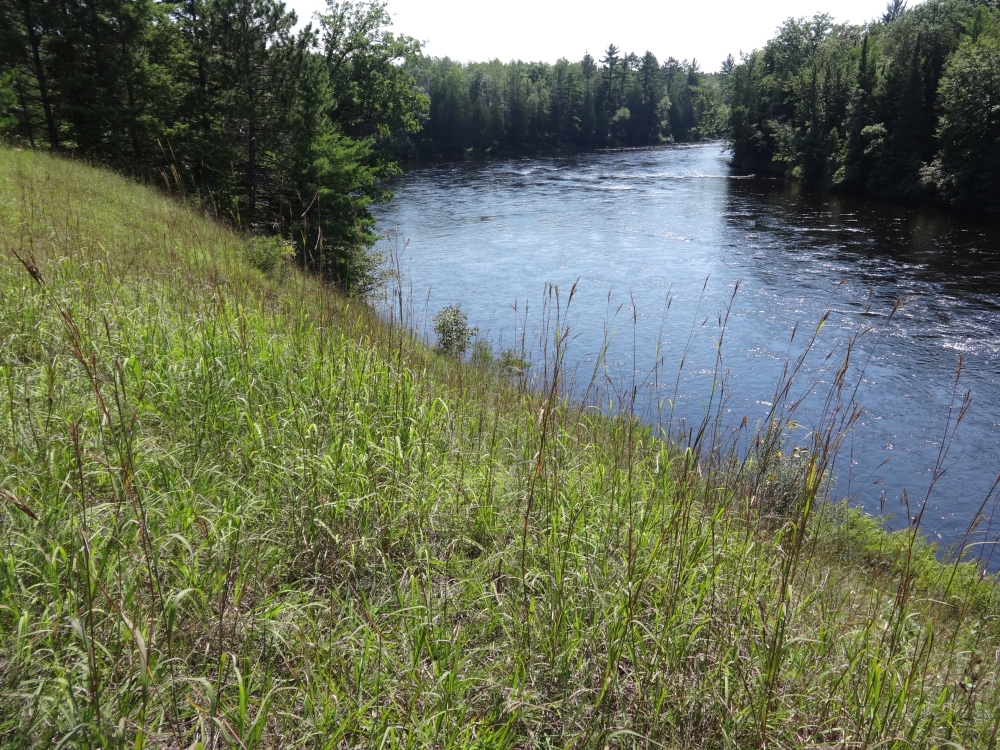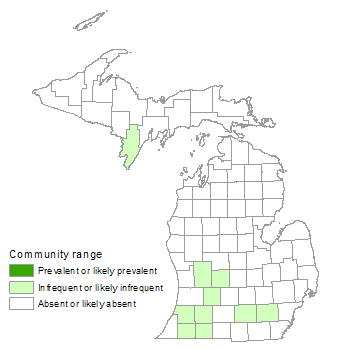Hillside Prairie
Overview
Hillside prairie is a grassland or savanna community that occurs on moderate to steep exposed slopes and crests of hills associated with river valleys, streams, or kettle lakes, surrounded by oak forest or oak savanna. This natural community is almost always found on south- to west-facing slopes, where exposure to sunlight is highest. Soils are typically strongly acid to neutral loamy sand or sandy loam, and often mixed with gravel. Hillside prairie is notable for supporting several state-listed plant species largely restricted to this community type.
Rank
Global Rank: G3 - Vulnerable
State Rank: S1 - Critically imperiled

Landscape Context
Hillside prairie occurs on steep slopes and crests of hills associated with river valleys, streams, or kettle lakes, surrounded by oak forest (dry southern forest, dry-mesic southern forest, or dry-mesic northern forest) or oak savanna (oak barrens or oak openings). This community almost always occupies south- to west-facing slopes, where exposure to sunlight is highest. It is found primarily in southern Lower Michigan, where occurrences are concentrated in Kent, Kalamazoo, and Jackson Counties. One occurrence is known from the western Upper Peninsula. Due to the specific combination of slope, aspect, and soil type, hillside prairie occurrences are local and of very small size.
Soils
Soils are well-drained, sandy loam to loamy sand and can range from strongly acid to neutral. Gravel is often present at or near the surface. One occurrence of hillside prairie is associated with exposed pre-glacial fluvial deposits of shale and conglomerate rocks.
Natural Processes
Open conditions of hillside prairie are maintained by fire, droughty soils, steep slopes, and soil erosion. Fire likely played a significant role in maintaining open conditions prior to European settlement based on the dominance of oaks in the surrounding landscape and presence of trails that led through or passed by several hillside prairie sites, suggesting their use as Native American encampments. In addition to preserving open conditions, fire helps maintain species diversity by facilitating seed germination, opening microsites for seedling establishment and growth of small species, and releasing important plant nutrients that bolster plant growth, flowering, and seed set.
Several factors contribute to the droughty conditions of hillside prairie. Steep slopes and sandy soils facilitate rapid drainage. Exposed slopes of southerly to westerly aspect are exposed to high amounts of incident sunlight, which increases soil temperatures and the rate of evapotranspiration at the ground level. Xeric conditions on exposed hillsides and hilltops are further enhanced by the prevailing southwesterly winds, which increase water loss from plants and soils.
Due to the steep slopes of hillside prairie, soil erosion and slumping are common. These processes contribute to maintaining open conditions and species diversity. Seed germination and seedling establishment of several small species may be aided by soil erosion and associated slumping as the bare soil patches provide suitable habitat for low-growing species that would otherwise be eliminated by competition from taller, more robust herbaceous plants.
Vegetation
Prior to European settlement and subsequent fire suppression, the canopy layer was likely absent to sparse, with scattered open-grown trees of black oak (Quercus velutina), white oak (Q. alba), pignut hickory (Carya glabra), and white pine (Pinus strobus). Currently, many remnants have locally dense canopies of the same species, in addition to the presence of mesophytic tree species that thrive in low-light conditions. Cover of the subcanopy and shrub layers has also increased in many hillside prairies due to a lack of fire. Characteristic species of the overstory, understory, and shrub layers include quaking aspen (Populus tremuloides), sassafras (Sassafras albidum), red-cedar (Juniperus virginiana), ironwood (Ostrya virginiana), witch hazel (Hamamelis virginiana), juneberry (Amelanchier arborea), staghorn sumac (Rhus typhina), and American hazelnut (Corylus americana). Remnant prairie openings, often very limited in extent, are typically dominated by little bluestem (Schizachyrium scoparium), big bluestem (Andropogon gerardii), porcupine grass (Hesperostipa spartea), and Pennsylvania sedge (Carex pensylvanica), with Indian grass (Sorghastrum nutans) occasionally important in more mesic microhabitats on middle and lower slopes. The invasive grasses Canada bluegrass (Poa compressa) and Kentucky bluegrass (P. pratensis) are common in most sites. Other commonly occurring ground flora include thimbleweed (Anemone cylindrica), milkweeds (Asclepias spp.), asters (Symphyotrichum spp.), harebell (Campanula rotundifolia), New Jersey tea (Ceanothus americanus), bastard toadflax (Comandra umbellata), flowering spurge (Euphorbia corollata), northern bedstraw (Galium boreale), round-leaved hepatica (Hepatica americana), alum root (Heuchera spp.), cylindrical blazing star (Liatris cylindracea), northern blazing star (L. scariosa), hoary puccoon (Lithospermum canescens), hairy beard-tongue (Penstemon hirsutus), prairie ragwort (Packera paupercula var. pseudotomentosa), false Solomon’s seal (Maianthemum racemosum), goldenrods (Solidago spp.), birdfoot violet (Viola pedata), and summer grape (Vitis aestivalis). In Michigan, several rare plant species are nearly restricted to hillside prairie, including kitten-tails (Besseya bullii, state endangered), side-oats grama grass (Bouteloua curtipendula, state endangered), and prairie golden alexanders (Zizia aptera, state threatened); their close affinity to hillside prairies allows them to serve as potential indicators for this community.
For information about plant species, visit the Michigan Flora website.
Plant Lists
Graminoids
- big bluestem (Andropogon gerardii)
- side-oats grama (Bouteloua curtipendula)
- Pennsylvania sedge (Carex pensylvanica)
- poverty grass (Danthonia spicata)
- porcupine grass (Hesperostipa spartea)
- wood-rushes (Luzula acuminata and L. multiflora)
- little bluestem (Schizachyrium scoparium)
- Indian grass (Sorghastrum nutans)
Forbs
- thimbleweed (Anemone cylindrica)
- wild columbine (Aquilegia canadensis)
- milkweeds (Asclepias amplexicaulis, A. verticillata, and others)
- kitten-tails (Besseya bullii)
- harebell (Campanula rotundifolia)
- spring-beauty (Claytonia virginica)
- bastard-toadflax (Comandra umbellata)
- common whitlow-grass (Draba reptans)
- robin’s-plantain (Erigeron pulchellus)
- flowering spurge (Euphorbia corollata)
- American columbo (Frasera caroliniensis)
- northern bedstraw (Galium boreale)
- pale avens (Geum virginianum)
- round-leaved hepatica (Hepatica americana)
- alum roots (Heuchera richardsonii and H. americana)
- cylindrical blazing-star (Liatris cylindracea)
- northern blazing-star (Liatris scariosa)
- hoary puccoon (Lithospermum canescens)
- false spikenard (Maianthemum racemosum)
- prairie ragwort (Packera paupercula)
- hairy beard-tongue (Penstemon hirsutus)
- Seneca snakeroot (Polygala senega)
- early buttercup (Ranunculus fascicularis)
- old-field goldenrod (Solidago nemoralis)
- elm-leaved goldenrod (Solidago ulmifolia)
- asters (Symphyotrichum laeve, S. urophyllum, and S. sericeum)
- yellow-pimpernel (Taenidia integerrima)
- early meadow-rue (Thalictrum dioicum)
- rue-anemone (Thalictrum thalictroides)
- birdfoot violet (Viola pedata)
- prairie golden alexanders (Zizia aptera)
Woody Vines
- summer grape (Vitis aestivalis)
Shrubs
- New Jersey tea (Ceanothus americanus)
- dogwoods (Cornus spp.)
- American hazelnut (Corylus americana)
- witch-hazel (Hamamelis virginiana)
- winged sumac (Rhus copallina)
- staghorn sumac (Rhus typhina)
Trees
- juneberry (Amelanchier arborea)
- pignut hickory (Carya glabra)
- flowering dogwood (Cornus florida)
- red-cedar (Juniperus virginiana)
- ironwood (Ostrya virginiana)
- white pine (Pinus strobus)
- quaking aspen (Populus tremuloides)
- white oak (Quercus alba)
- black oak (Quercus velutina)
- sassafras (Sassafras albidum)
Noteworthy Animals
Hillside prairies and the surrounding oak opening habitat once supported a rich diversity of invertebrates including numerous species of butterflies, skippers, grasshoppers, and locusts. Mound-building ants mix and aerate the soil.
Rare Plants
- Aristolochia serpentaria (Virginia snakeroot, state threatened)
- Besseya bullii (kitten-tails, state threatened)
- Bouteloua curtipendula (side-oats grama grass, state threatened)
- Draba reptans (creeping whitlow-grass, state threatened)
- Eragrostis pilosa (small love grass, state special concern)
- Kuhnia eupatorioides (false boneset, state special concern)
- Panicum leibergii (Leiberg’s panic-grass, state threatened)
- Ranunculus rhomboideus (prairie buttercup, state threatened)
- Ruellia humilis (hairy ruellia, state threatened)
- Scutellaria parvula (small skullcap, state threatened)
- Zizia aptera (prairie golden alexanders, state threatened)
Rare Animals
- Chlosyne gorgone carlota (Gorgone checkerspot, state special concern)
- Erynnis p. persius (Persius duskywing, state threatened)
- Flexamia delongi (leafhopper, state special concern)
- Lepyronia gibbosa (Great Plains spittlebug, state threatened)
- Speyeria idalia (regal fritillary, state endangered)
Biodiversity Management Considerations
Conservation priorities for hillside prairies include identifying, protecting, and managing existing remnants where they occur. Fire suppression has resulted in conversion of many hillside prairies to closed-canopy forests, and continues to threaten existing sites. Open conditions can be restored through the use of prescribed fire. The initial step of cutting and herbiciding shrubs and trees may be necessary in overgrown sites. The sand and gravel substrate on steep slopes is prone to erosion, so care must be taken to prevent excessive foot traffic and soil disturbance. Invasive species can be controlled with fire, cutting, and herbicide application. Because several rare plants are nearly restricted to this habitat in Michigan, land stewards should take precautions to avoid direct impacts to these species from herbicide or excessive soil disturbance.
Much of our current knowledge of hillside prairie is based on studies of kitten-tails populations in Michigan, Indiana, Illinois, Wisconsin, and Minnesota. Current and historic locations for kitten-tails, side-oats grama, and other indicator species may serve as a guide to the locations of additional, potentially restorable former hillside prairies. Predictive GIS-based models that utilize landscape characteristics associated with the community may also be helpful in finding restorable sites.
Soil erosion, gravel mining, road construction, dumping, and invasive species all act as threats to the viability of hillside prairie. Invasive species that threaten the diversity and community structure of hillside prairie include spotted knapweed (Centaurea stoebe), common St. John’s-wort (Hypericum perforatum), autumn olive (Elaeagnus umbellata), multiflora rose (Rosa multiflora), common buckthorn (Rhamnus cathartica), Eurasian honeysuckles (Lonicera maackii, L. morrowii, L. tatarica, and L. xbella), and black locust (Robinia pseudoacacia). Other non-native plants, such as Canada bluegrass (Poa compressa), Kentucky bluegrass (P. pratensis), sheep sorrel (Rumex acetosella), and hawkweeds (Hieracium spp.), can be ubiquitous within hillside prairie remnants, yet their impacts on overall species composition and diversity have not been studied.
The landscape context of hillside prairies on steep, often scenic bluffs overlooking permanent bodies of water has led to the destruction of many remnants due to residential construction.
Variation
Middle and lower slopes may support mesic and wet-mesic conditions, respectively. White pine is an important canopy constituent in some occurrences.
Similar Natural Communities
Steep slope, south- to west-aspect, and plant species indicators differentiate hillside prairie from other similar prairie, savanna, and oak-dominated communities such as dry sand prairie, mesic sand prairie, dry-mesic prairie, mesic prairie, oak barrens, oak-pine barrens, oak openings, dry southern forest, and dry-mesic southern forest.
Places to Visit
- Pemene Falls, Escanaba State Forest Management Unit, Menominee Co.
- MacCready Reserve, Michigan State University, Jackson Co.
Relevant Literature
- Chapman, K.A. 1981. Besseya bullii (Eaton) Rydb. Kitten tails (Scrophulariaceae) in Michigan. Report to U.S. Fish and Wildlife Service.
- Chapman, K.A. 1984. An ecological investigation of native grassland in southern Lower Michigan. M.A. thesis, Western Michigan University, Kalamazoo, MI. 235 pp.
- Cochrane, T.S., and H.H. Iltis. 2000. Atlas of the Wisconsin prairie and savanna flora. Technical Bulletin No. 191. Department of Natural Resources, Madison, WI.
- Cole, E.J. 1901. Grand Rapids Flora. A. Van Dort, Grand Rapids, MI.
- Evers, R.A. 1955. Hill prairies of Illinois. Illinois Natural History Survey Bulletin 26: 366-446.
- Hanes, C.R., and F. Hanes. 1947. The flora of Kalamazoo County, Michigan. Anthoensen Press, Kalamazoo, MI. 295 pp.
- NatureServe. 2006. NatureServe Explorer: An online encyclopedia of life [Web application]. Version 6.1. NatureServe, Arlington, VA. Available http://www.natureserve.org/explorer. (Accessed: December 18, 2006.)
Citation
Cohen, J.G., M.A. Kost, B.S. Slaughter, D.A. Albert, J.M. Lincoln, A.P. Kortenhoven, C.M. Wilton, H.D. Enander, and K.M. Korroch. 2020. Michigan Natural Community Classification [web application]. Michigan Natural Features Inventory, Michigan State University Extension, Lansing, Michigan. Available https://mnfi.anr.msu.edu/communities/classification. (Accessed: January 5, 2026).
Kost, M.A., D.A. Albert, J.G. Cohen, B.S. Slaughter, R.K. Schillo, C.R. Weber, and K.A. Chapman. 2007. Natural Communities of Michigan: Classification and Description. Michigan Natural Features Inventory, Report No. 2007-21, Lansing, MI.


